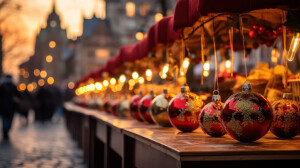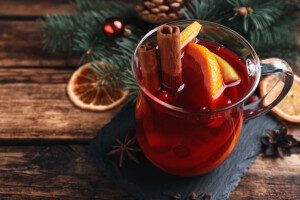 Strolling through a German Christmas Market—such as Nuremberg’s Christkindelsmarkt—with a glass of steaming Glühwein warming up your hands is a dream come true (or a fantasy yet to be fulfilled) for lovers of Christmas, European travel, and cold winter nights. Glühwein—the name actually means glow wine, noting the warm glow one should feel along with the first sip—is a big part of the German Christmas Market experience.
Strolling through a German Christmas Market—such as Nuremberg’s Christkindelsmarkt—with a glass of steaming Glühwein warming up your hands is a dream come true (or a fantasy yet to be fulfilled) for lovers of Christmas, European travel, and cold winter nights. Glühwein—the name actually means glow wine, noting the warm glow one should feel along with the first sip—is a big part of the German Christmas Market experience.
Of course, Christmas markets are a tradition all over Europe, and you can sip a version of Glühwein in Paris, London, Vienna, or wherever your travels take you. It might be known by a local name—such as vino caliente, glögg, vin brulé, bisschopswijn, vin chaud, or vinho quente—but whatever you call it, you are likely to end up with a comforting and spicy glass of warm wine in your hands.
 If you’d like to try and create your own home-kitchen version of Glühwein, try riffing on this formula (or follow one of the more formal recipes linked to the bottom of this post):
If you’d like to try and create your own home-kitchen version of Glühwein, try riffing on this formula (or follow one of the more formal recipes linked to the bottom of this post):
- First step: make a simple syrup by combing ¼ cup sugar with ¾ cup water in a large saucepan. Place over low heat and stir until the sugar dissolves completely. Add the zest of one orange, the juice of one orange, and your favorite spices—a good recommendation includes 2 or 3 cloves, a grate of nutmeg, and one cinnamon stick—to the pan. Simmer on very low heat for two minutes.
- Next: add one bottle of dry red wine. Keep in mind that this is one time where you can get away with using an inexpensive bottle. Using a very low setting, allow the mixture to heat. Keep the temperature low enough to avoid simmering and continue heating the mixture for at least 20 minutes.
- The flourish: Strain the mixture and serve in a small mug with a handle. Garnish with cinnamon sticks, orange peel, dried lemons, orange slices, or anything you like. Some people like to add a shot of rum or brandy to each glass.
For serious students of wine and spirits: You might be interested to know that two versions of (commercially produced) German Glühwein have Protected Geographical Indication (GI) status in the EU. According to the exacting standards of the EU, these products—Thüringer Glühwein and Nürmberger Glühwein—are aromatized wine-based drinks made with EU wine and flavored mainly with clove and cinnamon. Here are the details:
- Thüringer Glühwein: Produced in the region of Thuringia, Thüringer Glühwein is based on red wine that has been sweetened and flavored with cloves, cinnamon, vanilla, bitter orange, and/or lemon zest (other flavorings are also allowed).
- Nürmberger Glühwein: Produced in the city of Nuremberg, Nürmberger Glühwein is based on red wine that has been sweetened and flavored with cinnamon, cloves, and blueberries (other flavorings are also allowed).
- Nümnberger Glühwein aus Weisswein: Also produced in the city of Nuremberg, Nürmberger Glühwein aus Weisswein is based on white wine and flavored with some combination of cloves, cinnamon, cardamom, mace, nutmeg, star anise, vanilla, lemon zest, and bitter orange.
Recipes, references, and more information:
- Click here for a German-style Glühwein recipe from the Kitchn
- Click here for a recipe for a French version (vin chaud) from David Lebovitz
- Click here for a recipe for a Spanish-style version from Spanish Sabores
- EU Standards for Aromatized Wine Beverages
- Product Specification—Nümberger Glühwein GI
- Product Specification—Thüinger Glühwein GI
- https://www.christkindlesmarkt.de/en/
Post authored by Jane A. Nickles…your blog administrator: jnickles@societyofwineeducators.org